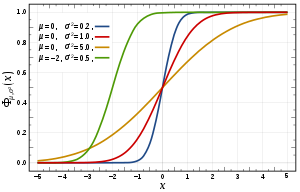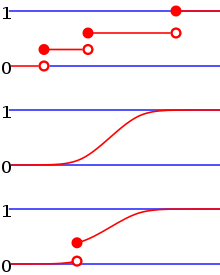Cumulative distribution function
This article needs additional citations for verification. (March 2010) (Learn how and when to remove this template message) |
In probability theory and statistics, the cumulative distribution function (CDF) of a real-valued random variable , or just distribution function of , evaluated at , is the probability that will take a value less than or equal to .
In the case of a continuous distribution, it gives the area under the probability density function from minus infinity to . Cumulative distribution functions are also used to specify the distribution of multivariate random variables.
Contents
Definition[edit]
The cumulative distribution function of a real-valued random variable is the function given by[1]:p. 77
|
where the right-hand side represents the probability that the random variable takes on a value less than or equal to . The probability that lies in the semi-closed interval , where , is therefore[1]:p. 84
|
In the definition above, the "less than or equal to" sign, "≤", is a convention, not a universally used one (e.g. Hungarian literature uses "<"), but is important for discrete distributions. The proper use of tables of the binomial and Poisson distributions depends upon this convention. Moreover, important formulas like Paul Lévy's inversion formula for the characteristic function also rely on the "less than or equal" formulation.
If treating several random variables etc. the corresponding letters are used as subscripts while, if treating only one, the subscript is usually omitted. It is conventional to use a capital for a cumulative distribution function, in contrast to the lower-case used for probability density functions and probability mass functions. This applies when discussing general distributions: some specific distributions have their own conventional notation, for example the normal distribution.
The CDF of a continuous random variable can be expressed as the integral of its probability density function as follows:[1]:p. 86
In the case of a random variable which has distribution having a discrete component at a value ,
If is continuous at , this equals zero and there is no discrete component at .
Properties[edit]
Every cumulative distribution function is non-decreasing[1]:p. 78 and right-continuous[1]:p. 79, which makes it a càdlàg function. Furthermore,
Every function with these four properties is a CDF, i.e., for every such function, a random variable can be defined such that the function is the cumulative distribution function of that random variable.
If is a purely discrete random variable, then it attains values with probability , and the CDF of will be discontinuous at the points and constant in between:
If the CDF of a real valued random variable is continuous, then is a continuous random variable; if furthermore is absolutely continuous, then there exists a Lebesgue-integrable function such that
for all real numbers and . The function is equal to the derivative of almost everywhere, and it is called the probability density function of the distribution of .
Examples[edit]
As an example, suppose is uniformly distributed on the unit interval . Then the CDF of is given by
Suppose instead that takes only the discrete values 0 and 1, with equal probability. Then the CDF of is given by
Derived functions[edit]
Complementary cumulative distribution function (tail distribution)[edit]
Sometimes, it is useful to study the opposite question and ask how often the random variable is above a particular level. This is called the complementary cumulative distribution function (ccdf) or simply the tail distribution or exceedance, and is defined as
This has applications in statistical hypothesis testing, for example, because the one-sided p-value is the probability of observing a test statistic at least as extreme as the one observed. Thus, provided that the test statistic, T, has a continuous distribution, the one-sided p-value is simply given by the ccdf: for an observed value of the test statistic
In survival analysis, is called the survival function and denoted , while the term reliability function is common in engineering.
- Properties
- For a non-negative continuous random variable having an expectation, Markov's inequality states that[2]
- As , and in fact provided that is finite.
- Proof:[citation needed] Assuming has a density function , for any
- Then, on recognizing and rearranging terms,
- as claimed.
Folded cumulative distribution[edit]

While the plot of a cumulative distribution often has an S-like shape, an alternative illustration is the folded cumulative distribution or mountain plot, which folds the top half of the graph over,[3][4] thus using two scales, one for the upslope and another for the downslope. This form of illustration emphasises the median and dispersion (specifically, the mean absolute deviation from the median[5]) of the distribution or of the empirical results.
Inverse distribution function (quantile function)[edit]
If the CDF F is strictly increasing and continuous then is the unique real number such that . In such a case, this defines the inverse distribution function or quantile function.
Some distributions do not have a unique inverse (for example in the case where for all , causing to be constant). This problem can be solved by defining, for , the generalized inverse distribution function:
- Example 1: The median is .
- Example 2: Put . Then we call the 95th percentile.
Some useful properties of the inverse cdf (which are also preserved in the definition of the generalized inverse distribution function) are:
- is nondecreasing
- if and only if
- If has a distribution then is distributed as . This is used in random number generation using the inverse transform sampling-method.
- If is a collection of independent -distributed random variables defined on the same sample space, then there exist random variables such that is distributed as and with probability 1 for all .
The inverse of the cdf can be used to translate results obtained for the uniform distribution to other distributions.
Multivariate case[edit]
Definition for two random variables[edit]
When dealing simultaneously with more than one random variable the joint cumulative distribution function can also be defined. For example, for a pair of random variables , the joint CDF is given by[1]:p. 89
|
where the right-hand side represents the probability that the random variable takes on a value less than or equal to and that takes on a value less than or equal to .
Definition for more than two random variables[edit]
For random variables , the joint CDF is given by
|
Interpreting the random variables as a random vector yields a shorter notation:
Properties[edit]
Every multivariate CDF is:
- Monotonically non-decreasing for each of its variables,
- Right-continuous in each of its variables,
Complex case[edit]
Complex random variable[edit]
The generalization of the cumulative distribution function from real to complex random variables is not obvious because expressions of the form make no sense. However expressions of the form make sense. Therefore, we define the cumulative distribution of a complex random variables via the joint distribution of their real and imaginary parts:
- .
Complex random vector[edit]
Generalization of Eq.4 yields
as definition for the CDS of a complex random vector .
Use in statistical analysis[edit]
The concept of the cumulative distribution function makes an explicit appearance in statistical analysis in two (similar) ways. Cumulative frequency analysis is the analysis of the frequency of occurrence of values of a phenomenon less than a reference value. The empirical distribution function is a formal direct estimate of the cumulative distribution function for which simple statistical properties can be derived and which can form the basis of various statistical hypothesis tests. Such tests can assess whether there is evidence against a sample of data having arisen from a given distribution, or evidence against two samples of data having arisen from the same (unknown) population distribution.
Kolmogorov–Smirnov and Kuiper's tests[edit]
The Kolmogorov–Smirnov test is based on cumulative distribution functions and can be used to test to see whether two empirical distributions are different or whether an empirical distribution is different from an ideal distribution. The closely related Kuiper's test is useful if the domain of the distribution is cyclic as in day of the week. For instance Kuiper's test might be used to see if the number of tornadoes varies during the year or if sales of a product vary by day of the week or day of the month.
See also[edit]
References[edit]
- ^ a b c d e f Park,Kun Il (2018). Fundamentals of Probability and Stochastic Processes with Applications to Communications. Springer. ISBN 978-3-319-68074-3.
- ^ Zwillinger, Daniel; Kokoska, Stephen (2010). CRC Standard Probability and Statistics Tables and Formulae. CRC Press. p. 49. ISBN 978-1-58488-059-2.
- ^ Gentle, J.E. (2009). Computational Statistics. Springer. ISBN 978-0-387-98145-1. Retrieved 2010-08-06.[page needed]
- ^ Monti, K.L. (1995). "Folded Empirical Distribution Function Curves (Mountain Plots)". The American Statistician. 49: 342–345. doi:10.2307/2684570. JSTOR 2684570.
- ^ Xue, J. H.; Titterington, D. M. (2011). "The p-folded cumulative distribution function and the mean absolute deviation from the p-quantile". Statistics & Probability Letters. 81 (8): 1179–1182. doi:10.1016/j.spl.2011.03.014.<
External links[edit]
 Media related to Cumulative distribution functions at Wikimedia Commons
Media related to Cumulative distribution functions at Wikimedia Commons




![(a,b]](https://wikimedia.org/api/rest_v1/media/math/render/svg/6a6969e731af335df071e247ee7fb331cd1a57ae)



















![[0,1]](https://wikimedia.org/api/rest_v1/media/math/render/svg/738f7d23bb2d9642bab520020873cccbef49768d)















![F^{-1}(p),p\in [0,1],](https://wikimedia.org/api/rest_v1/media/math/render/svg/b89fe1b58ff06ad5647ba178886bb6704d8da846)



![p\in [0,1]](https://wikimedia.org/api/rest_v1/media/math/render/svg/33c3a52aa7b2d00227e85c641cca67e85583c43c)










![U[0,1]](https://wikimedia.org/api/rest_v1/media/math/render/svg/ef4a82b2a883d751cf53e5ac11ea12b9e36298f0)






















